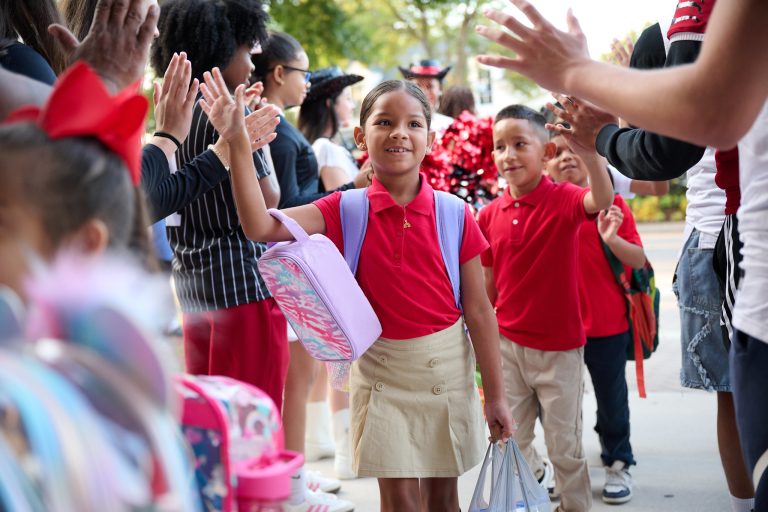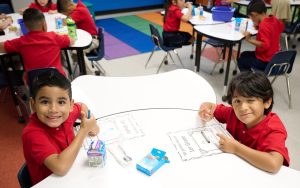At John J. Pershing Elementary School, diversity is a superpower.
Over 80% of the student population identifies as Hispanic. And many recently moved to the U.S.
Students bring with them a wide range of life experiences, cultures, family backgrounds, and talents. Meeting the unique needs of each child while uplifting and celebrating their diversity can be a challenge, but teachers and administrators say it is their calling.
“We stay here — and in the profession — because we have a passion for it,” said Maria Fernandez, a fourth-grade teacher. “It’s vocational. We could be in any other place, but we stay.”
A little over 10% of the student population is Black, and 1.2% is Indigenous. Almost 4% identify as White.
The teachers at Pershing are just as diverse as their students.
 Not only do educators represent different cultures, they also came to Pershing in different ways. Some are new teachers. Others are veterans, with over 24 years of experience. A handful are former lawyers, who pursued their passion for education as a second career.
Not only do educators represent different cultures, they also came to Pershing in different ways. Some are new teachers. Others are veterans, with over 24 years of experience. A handful are former lawyers, who pursued their passion for education as a second career.The school’s diversity, combined with the commitment to building relationships with students and their families, are key to establishing a lasting legacy of excellence.
“Everybody is pursuing academic excellence first. But we don’t want to forget the base of that excellence is on authentic relationships with the students – authentic and diverse,” Fernandez said.
Students at Pershing consistently receive high marks on STAAR tests. At least 30% reached the Master’s Level, meaning they are expected to succeed in the next grade or course with little or no academic intervention. Additionally, students scored high in the Meets and Exceptional categories, coming in at least 62% and 91% respectively.
These results are due in part to the various teaching styles students have the opportunity to learn from.
“We are really diverse – the way that we teach, the way that we are,” Fernandez said.
For example, she noticed students lacked confidence in vocabulary and interest in reading when they returned to school after the COVID-19 pandemic. So, to make it interesting, Fernandez incorporated drama into reading lessons by using puppets and having her students put on shows for the younger kids. The students now look forward to being in fourth grade so they can play with puppets, she said.
Rafael Gonzalez, a fourth-grade teacher, brought in a class pet that not only offers positive reinforcement for good behavior, but also teaches students responsibility.
“It’s a random system that decides who gets to take care of the pet,” he said. “Sometimes, it’s whoever scored the highest on tests. But that’s not fair to do all the time. So another week, it’s who showed the most citizenship skills. I sometimes think they learn better with the pet in the classroom.”
At Pershing, the kids are more than students. They are people, and teachers make a point to develop relationships with each and every person who walks through their door.
As a result, student surveys revealed a 91% overall satisfaction rating, with students feeling safe and valuing their educational experience. And when students feel valued, safe, and enjoy learning, they are empowered to take education seriously.
“When you’re building relationships with the students, that’s what makes them feel safe and valued,” said Brooke Rivera, third-and-fourth-grade teacher. “They see the teacher cares more than just about them getting Master’s on the test.”
While Pershing follows district safety protocols, Lourdes Morales-Figueroa, principal of Pershing, says a culture of safety is so much more than having systems in place.
“Safety is a feeling of love, respect and value. But it’s also the place that a student can go here and know nothing’s going to happen to them, especially when you have newcomers that have been traveling through the jungle for three or four months,” she said.
Integral to the continued culture of excellence is buy-in from parents.
“A parent’s presence is essential. By ourselves, we cannot do it,” Morales-Figueroa said. “Their input, efforts and involvement is key.”
Parents do their best to make it to conferences. And when the school hosts events, parents fill the hallways, Gonzalez said.
“We need to welcome everyone in the school, and parents are included in that,” he said.
Rivera agreed.
“Parents want to come here. They feel seen. We know their names and their circumstances,” she said.
Her advice for teachers as they strive for their own model of excellence in their schools is to keep the joy in teaching.
“The teachers here have their own personality and are great at bringing that to their students. When I come to work, I enjoy it,” she said. “Teaching can be hard sometimes, but really find what about it brings you joy, and embrace that.”



